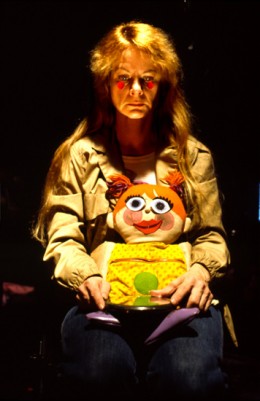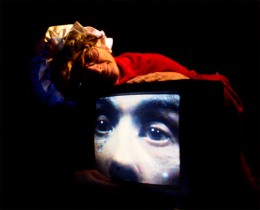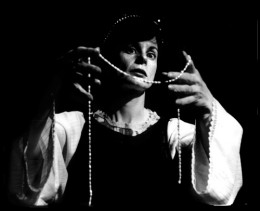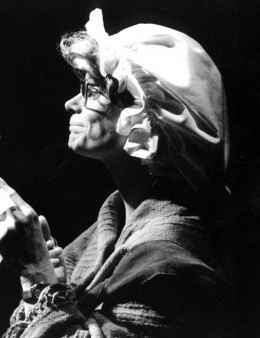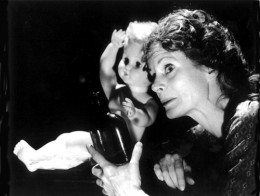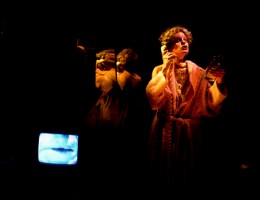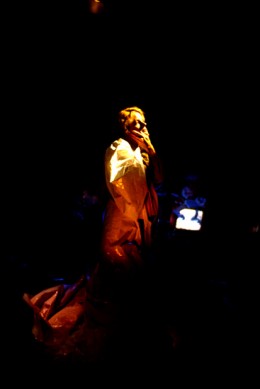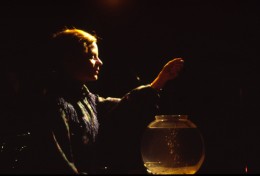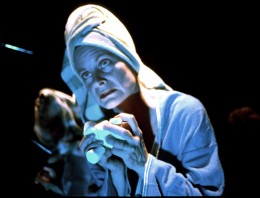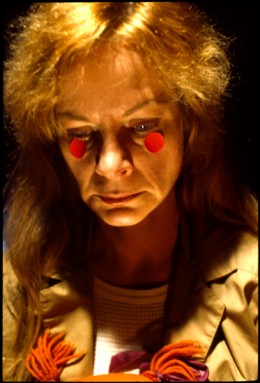A poem cycle imaging and imagining the voices of American women, ranging through Betsy Ross, Belle Starr the Bandit Queen, an astronomer, an assassin, and the Watergate Wives.
Texts of poems by Pamela White Hadas
Directed by Conrad Bishop
Performed by Elizabeth Fuller
Music by Michele Mercure
Designed by Linda Cunningham
Costumes by P. Chelsea Harriman
Produced by The Independent Eye, premiering May 24, 1990, at Eye Theatre Works (Lancaster, PA); extended runs at Touchstone Theatre (Bethlehem, PA) and New City Theatre (Seattle, WA). Total of 32 performances.
—Misha Berson, Seattle TimesWhat do Maria Mitchell, Blaze Starr, Betsy Ross, Patty Hearst and Pocahontas have in common?
All are in the gallery of emblematic American women portrayed in Beside Herself, a reverberant poem cycle by New York writer Pamela White Hadas. And all are enacted by the versatile Elizabeth Fuller in a multimedia piece based on the same poems. Produced by Pennsylvania’s Independent Eye company, it can be seen through Sunday at New City Theater.
But seen is not the operative verb here—heard is more apt. Language this dense with allusions, this cross-rhythmic, this ripe and teeming begs close listening. The staged Beside Herself: Pocahontas to Patty Hearst doesn’t always allow you that: unlike a poetry reading, it has to keep your eye engaged as well as your ears.
What director Conrad Bishop and actress Fuller have concocted is a recitation interlaced with semiabstract impersonations. But while static at times, these mini-biographies are not without visual interest.
Fuller changes costume for each character—long skirts and a six-shooter for Wild West outlaw Blaze Starr, a wedding dress for Tricia Nixon. Bishop’s lighting hides and reveals her in odd, arresting ways, and uses TV images now and then. The fine set by Linda Cunningham is a wilderness of mirrors and sculpted female forms, faceless and stripped bare—just as Hadas, in her poems, strips away masks and myths to get to her subjects’ essences.
The legendary Native American Pocahontas, though married to a white man and assimilated into English society, yearns for her father and “the mother I must have had.†The first woman astronomer, Maria Mitchell, exults in her “infinite†work, but also confides her loneliness: “A short affair with a comet can leave one warm but empty.â€
Presidential wife Pat Nixon craves “for the luxury of being able to frown for one whole day.†And though Starr seems tough and admits few regrets, her letters to her estranged daughter reek with a failed mother’s desperation and grief.
There’s a dissonance between role and reality for all these women, echoed in Michele Mercure’s synthesized music. But in the long Hearst segment, an authentic self never emerges. The horrific story of her abduction and its aftermath, spoken on tape by Fuller in the fictionalized words of Hearst’s mother, her “comrade†Emily Harris, a jury woman at her trial for bank robbery, and others, is what others say happened. The silent Patty wanders the stage with no voice of her own.
Beside Herself isn’t a comforting vision of American womanhood, and its 2 1/2 hours of dense-packed language can be heavy sledding. Poems could be cut rather than rushed and more humor would help. But the skill of Fuller blended with the force of the words can be spellbinding. When that happens, masks do lift and interior lives are revealed.
—Donald Marinelli, High PerformanceBeside Herself was a series of monologs based on a poem cycle by New York-based poet Pamela White Hadas. Described quite accurately by director Conrad Bishop as “an aural/visual montage of states of being of women in American history,†Beside Herself struck one as a historical feminist stream-of-consciousness, a reflection strengthened in hindsight by the accentuating synthesized music of composer Michele Mercure, the captivating female silhouettes by designer/sculptor Linda Cunningham that were adorned with partial costumes to further the immediate transformation of character and the television set that served strikingly as the masculine presence.
Beside Herself was also a theatrical tour-de-force for Independent Eye co-founder and actress Elizabeth Fuller. Fuller imaginatively and skillfully interpreted a dozen women from early to recent American history: Pocahontas, Betsy Ross, Belle Starr, the astronomer Maria Mitchell, ouija board medium Pearl Curran, Marsha Mitchell, Pat Nixon and Rosemary Woods of Watergate fame, an ex-Miss America and, in the most interesting vignette of them all, Patty Hearst.
This entourage confronted and challenged any sentimental notion of the role of women in American history. The “pioneer†caricature—stalwart, tough, yet homespun—was nowhere to be seen. Rather, we were struck with a palpable quality of injustice, abuse and existential exile that seemed to establish an immediate kinship between them and Native Americans. Yet they were strong-willed and determined, capable of and actually making significant accomplishments and impact upon the society of their time. The ongoing dilemma was that male-dominated America had imposed restrictions. It had presumed that childbearing and rearing was not only a woman’s role, it was to be their only role. And in so doing it alienated and fragmented women from attempting to understand, let alone realize, their potential fullness of being. It also contributed to the mother/daughter tension present in many of the characters.
The image evoked by the play’s title provided a guidepost to the overall structure of the piece. Hadas and Fuller have attempted to create a dynamic environment in order to uncover a true female self in the midst of a history that has never allowed women a genuine voice.
Pocahontas’ opening monolog set the tone for what was to follow. Torn and uprooted from her native land, Pocahontas was thrust into the strange world of British colonialism. Fuller captured this otherworldly tension as her Indian princess, bound and garbed in Western fashion, yearned to return to the “new†land, itself a kind of ultimate irony.
The last haunting monolog poem about Patty Hearst served as a perfect summation of the struggle. The scene found Hearst in her littered bedroom hearing herself defined solely through the voices of others: her mother, a girlfriend, a kidnapper, judge, jurors, reporters and even a fairy godmother. The image was that of a woman described, pegged and branded by others. Although she was capable of magical shifts in personality and identity, she apparently had no voice of her own. Patty Hearst was a woman “owned†by others. The fact that this was the last of the poems, and the most recent historically, underscored the importance of this work.
